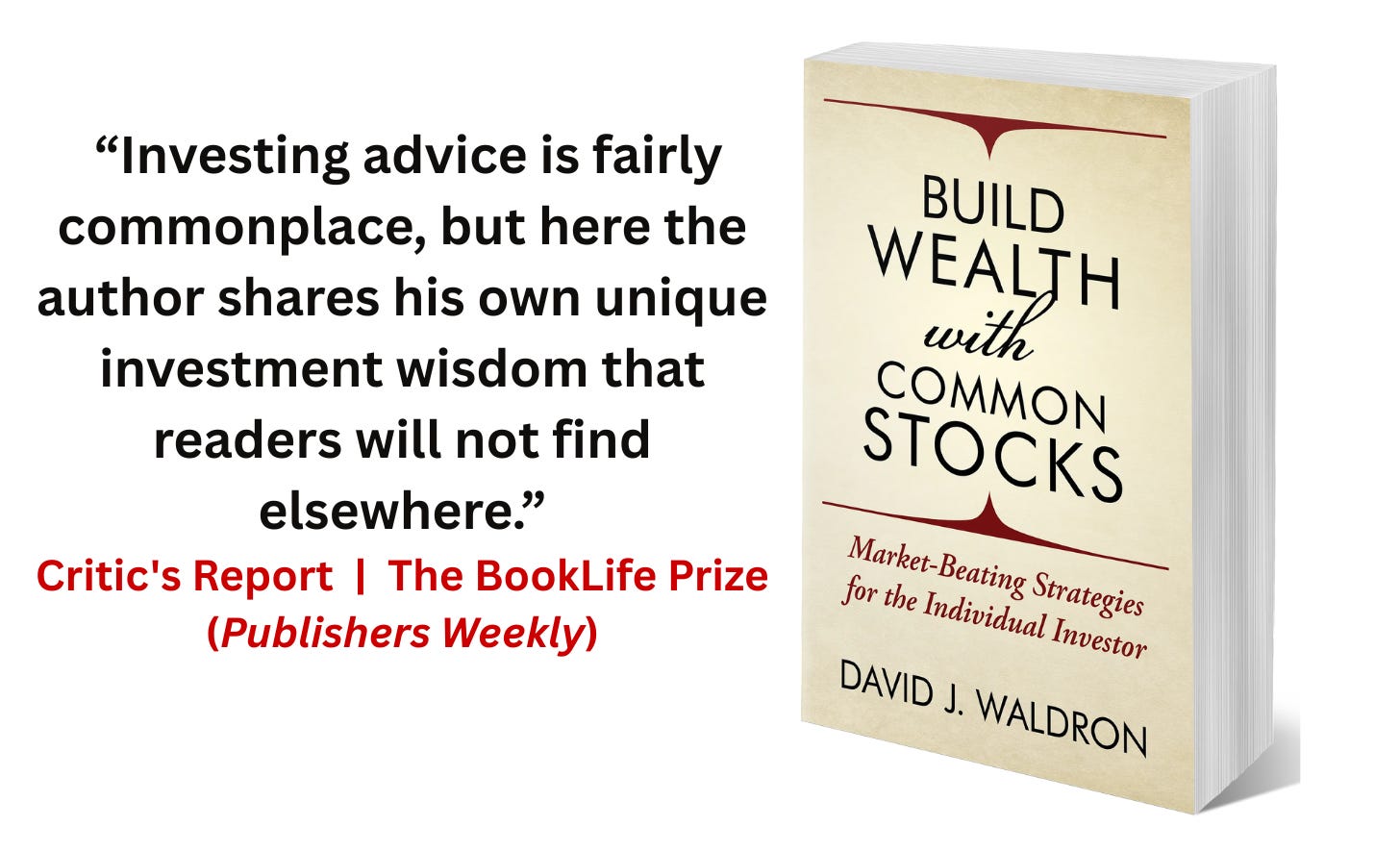Chapter Eleven: Define the Value Proposition
Revised and updated | Build Wealth with Common Stocks: Market-Beating Strategies for the Individual Investor
I sent this complete chapter by email instead of posting it, and mailing only a summary and link to inboxes. Although I prefer emailing a summary/link because of a more accurate readership record, I want subscribers to let me know what they like:
Audio voiceover:
Substack’s AI-generated voiceover is available from “Books by David J. Waldron.” To access it, open the chapter in the Substack app. Feel free to share your thoughts in the comments or via direct message. I will use AI to clone my voice for the book’s official audiobook release.
Learn more about audio voiceovers:
https://davidjwaldronbooks.substack.com/p/audio
Haven’t read the previous chapters? Find them here on the book’s webpages:
Books by DJW Author Website
https://davidjwaldronbooks.substack.com/p/build-wealth-with-common-stocks
Quality Value Investing Newsletter
https://davidjwaldron.substack.com/p/build-wealth-with-common-socks
Part II: Strategies
Chapter Eleven
Define the Value Proposition
How well do you know and understand the products or services provided by the publicly traded company behind the shares you own?
Your primary role as a do-it-yourself investor is to identify the organization's value proposition. An enterprise’s value proposition is the sum of its competitive advantages in the markets it serves, including the appeal of its products or services to customers. In your research, ask yourself, “What value do the products or services provide to current and potential customers?”
If you were in the general market for either, would you buy the company's goods or services?
Imagine a friend, the managing partner of a similar but privately owned business, inviting you to join as a partner. Assuming you have the necessary funds, would you accept the offer?
Your responses to these hypothetical questions demonstrate an understanding and confidence in the potential of the targeted business, reflecting its value proposition or competitive edge toward sustained growth and success, as indicated by the stock price over time. A publicly traded company that presents a clear and compelling value proposition is as sought after as a stock trading at attractive valuation multiples.
This chapter explains how to define a company's value proposition for its products or services and confidently communicate it with an elevator pitch. When researching a stock, review at least the following areas to evaluate the business's competitive advantages.
The Inherent Value of an SEC Filing
Beyond what is already known about the company's products or services, retail investors have a wealth of public information available to evaluate the value proposition.
The most reliable data for the enterprise comes from its filings with the US Securities and Exchange Commission (SEC) or an equivalent in other countries.
The thoughtful and disciplined investor reviews SEC filings, such as the 10-K annual reports, 10-Q quarterly reports, and 8-K current event reports. SEC filings are the primary public resources for due diligence on a company's value proposition and its products or services. Find this information in the investor relations section of the company's website, through your online broker, or on your preferred investment site.
Take time to explore the organization's online presence, including its website, social media, marketing channels like advertising, and public and investor relations. As the initial step in thorough investment research, the two main priorities for the independent investor are reading the Form 10-K report that the organization files with the SEC annually and reviewing the investor relations site.
For example, the 10-K, especially the section titled Item 1 Business, is where management provides an in-depth discussion of the company. Topics include the company's background and history, corporate strategy, specific products and services, markets and distribution channels, competition, supply chains, research and development, intellectual property, foreign and domestic operations, and other industry-specific items. While the details can be lengthy and dry, the information offers a roadmap of the product’s or service’s potential to increase the stock price over the long term.
Apple's investor website and SEC filings are among the best prepared and easiest to understand of the companies in the S&P 500; transparency is often weak and elusive in many other enterprises.
I challenge those who tend to skip annual reports and other SEC filings to discover organizational, product, regulatory, and financial facts about the company that they were unaware of before reading. These documents are dense with legal language and number crunching. A careful reading often reveals bits of information that give you a virtual glimpse inside—at least—of the plants, stores, e-commerce operations, C-suites, and boardrooms.
Competitive Advantages of Products or Services
A profitable retail common stock portfolio is like a collection of shares in well-run companies offering popular products or services with lasting competitive advantages.
Based on the relentless commitment to price and quality, how does the thoughtful investor define the competitive advantages of the company's products or services and their perceived lasting value relative to the market price?
One suggested method is to evaluate how the company's value proposition benefits each stakeholder.
Illustrate the Value Proposition with a Crayon
In Beating the Street, Peter Lynch emphasizes the importance of understanding what we invest in without falling into analysis paralysis: “Never invest in any idea you can’t illustrate with a crayon.”1
Lynch's idea came after he watched a middle school class that created an investment club guided by their teacher. Lynch observed that the stock choices made by the student investment club vastly outperformed the S&P 500 Index. Lynch and his student investors simplified the value proposition into a metaphorical crayon sketch that any investor can easily grasp and share.
Can you illustrate the value proposition of the company behind your favorite stock with a crayon, using a short sentence or phrase that symbolizes it?
The successful do-it-yourself investor doesn’t buy an asset just because it seems or feels right; instead, they allocate their hard-earned dollars to the common shares of businesses they understand and respect. The value proposition is often overlooked or taken for granted by retail investors. Conversely, institutional investors, such as portfolio managers and analysts, tend to overanalyze a company's product or service’s value proposition with extensive research to justify their fees and bonuses. The biggest mistake a stock picker can make is buying shares of a company with little knowledge of what it produces or how it benefits its target market.
The thoughtful, disciplined, and patient investor understands that the common stock of a company offering valuable, in-demand products and services withstands market cycles. This outcome prevails despite occasional erratic price movements caused by the shortsightedness of the crowd, including both individuals and professionals.
The Value Proposition Elevator Pitch
The Model Portfolio includes common shares of high-quality companies, chosen through a proprietary research model that assesses five key fundamentals: shareholder yields, management returns, valuation multiples, downside risks, and the value proposition, which is the focus of this chapter.
Begin your investment research by defining the company's competitive advantages in an elevator pitch with a brief sentence or phrase.
Below are the elevator pitches—my investment theses on the value proposition—of the stocks of three companies featured in The Model Portfolio. Please note that the overall view reflects each of the primary measures from the proprietary research model as of the quarter-end on September 30, 2025.
The Walt Disney Company (DIS) remains the dominant leader in media content.
Its in-demand, original content has driven a four-bagger stock since 2009. Disney is an excellent example of the power of compounding, no pun intended.
Johnson & Johnson (JNJ) is like holding a mutual fund of healthcare products.
Although the talc and opioid lawsuits against J&J posed real threats to the stock, the pharmaceutical giant has a history of overcoming obstacles.
NIKE, Inc. (NKE): the Swoosh is the moat (competitive advantage).
Phil Knight, the billionaire cofounder of the global apparel giant, paid $35 to a graphic design student at a college where he taught accounting courses for creating the now-famous logo of his athletic footwear start-up. Rest assured, NIKE later compensated her with a generous stock option grant.2 Great businesses succeed primarily because they take care of their stakeholders.
The Crowd Buys What Feels or Sounds Good
Understanding the value proposition of a publicly traded company, as reflected in its products or services, is crucial for the fundamental analysis of targeted common stock shares, enabling retail investors to buy, hold, and benefit from compounding total returns.
Begin with the 10-K annual report to learn about the products or services, as well as the employees, suppliers, markets, governments, and customers involved in producing, trading, regulating, and consuming the goods or services.
Next, try to summarize the company's value proposition in a brief phrase or elevator pitch. If you're comfortable with a basic understanding of the business, proceed with your due diligence and consider the possibility of owning part of the company through its common shares.
When struggling to define and explain the value proposition in the form of an elevator pitch, or—borrowing the metaphor of Peter Lynch’s market-beating investment club of seventh-graders—with a crayon, it might be best to move on to the next idea. Too many crowdsourced investors buy and sell shares based on market sentiment, trends, and fads without understanding the company's underlying value proposition.
Start with the Value Proposition in Mind
Understanding the products or services and the competitive advantages of the targeted company is essential for the successful retail investor.
To own a business, we need to understand the enterprise behind the numbers that make up the equity analysis. The crowd tends to overlook the intangible aspects of the business and overly focus on analyzing the more tangible metrics. The more you learn about the companies you invest in, the greater the chance your portfolio will outperform.
For example, if a friend or loved one asked you to invest in an unpatented invention for a wild virtual reality science fiction game based on a rough sketch and a newly earned engineering degree, would you?
Despite love and friendship's allure, you might invest little, if any, of your hard-earned money. Instead, focus on owning companies whose products or services you understand in principle, even if you don't use them. Start your research by defining the value proposition. If you can't explain it or if you're doubtful of any clear and concise competitive advantages, save your valuable time and funds for a better opportunity.
Next up: Chapter Twelve examines how to quantify shareholder yields.
CHAPTER ELEVEN SUMMARY
On Competitive Advantages
The value proposition of a publicly traded company is the total of its products' and services' competitive advantages in the markets it serves.
When researching a specific stock, it is essential to understand the company's value proposition before investing.
Review the filings submitted by senior management to the Securities and Exchange Commission (SEC), such as the 10-K annual reports, 10-Q quarterly reports, and 8-K current event reports, or an equivalent from another country.
If you cannot identify or understand the company's value proposition, consider skipping the stock.
Confidently understanding products, services, and competitive advantages is essential for the successful retail common stock investor.
This updated chapter is copyrighted 2021 and 2025 by David J. Waldron. All rights are reserved worldwide.
Next in Build Wealth with Common Stocks | Part II Strategies | Chapter Twelve: Quantify Shareholder Yields
Universal links allow you to preview or purchase David’s published print or ebooks — each available globally at your preferred online bookstores — with one or two clicks, brought to you by our trusted partner, BookFunnel.
Share the “Books by David J. Waldron” author website with your network to earn credits for a premium subscription that provides full-text and audio access to all of David’s manuscripts and updated chapters of his published self-help books.
Peter Lynch and John Rothchild, Beating the Street (New York: Simon & Schuster, 1993, 1994), 27.
Drake Baer, “How Nike Got An Insane Deal on The ‘Swoosh’ Logo,” Business Insider, July 25, 2014, https://www.businessinsider.com/nike-bought-swoosh-logo-for-35-2014-7.







